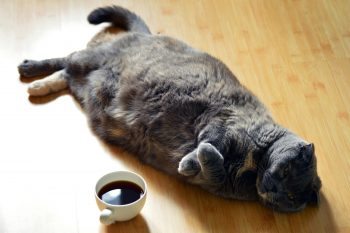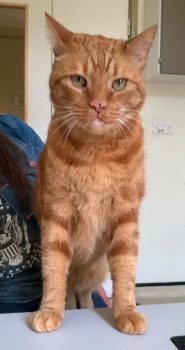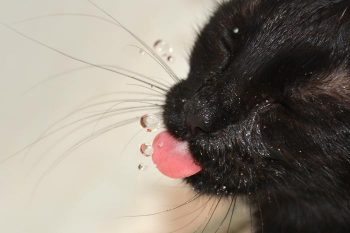27 Feb 2017
Feline endocrinology webinar series – the facts and myths
Join the RVC’s feline endocrinology experts Stijn Niessen and Yaiza Forcada on a journey through the facts and myths of cats and their hormones in this webinar series.

Symptoms of CKD include excessive thirst.
The field of feline endocrinology has not exactly been standing still. And with owners happily resorting to “Dr Google” both before and after each visit to the veterinary clinic, being prepared with updated, evidence-based knowledge in this area has never been more important.
Over four weeks, two of the RVC’s well-known feline endocrinology experts, Stijn Niessen and Yaiza Forcada, will take those who attend a webinar series on this topic on a journey through the facts and myths of cats and their hormones.
A sound evidence base and practical gems concerning the treatment of conditions such as feline diabetes mellitus (DM), hyperthyroidism, acromegaly and hyperaldosteronism promise to make it worthwhile to register for this popular series.
Feline diabetes mellitus – the latest

Recent years have seen many developments regarding our understanding of DM’s pathophysiology. This has resulted in a significant impact on what is perceived to be best treatment practice.
This webinar series will aim to provide delegates with a balanced view on these developments and will include an open-minded, evidence-based discussion on the assumed causes of DM.
For too long, we have assumed feline diabetes was just an issue of fat and inactivity, accumulating in a type-two-like diabetic state. Instead, updated clinicians should consider the involvement of conditions such as pancreatitis as a common, concurrent disease in diabetic cats that may be accountable for the DM in a proportion of cats. These cats may have signs of exocrine pancreatic insufficiency, but often do not.
Debate is ongoing whether diabetic cats with pancreatitis are all type-two diabetics with concurrent disease, or whether a proportion of cases suffer from pancreatitis-induced DM (a form of type-three DM).
Regardless of the outcome of this “chicken or the egg” discussion, a study has found feline pancreatic lipase immunoreactivity concentrations were consistently higher in samples from diabetic cats.
Pancreatitis should, therefore, at the very least, be considered as a possible interfering factor, especially when dealing with cats with variable diabetic control (periods of good control intermixed with periods of suboptimal control, despite consistently good management by the owner).
Acro-what?

Another significant form of non-type-two DM is acromegaly, or hypersomatotropism.
Inappropriate overproduction of growth hormone by the pituitary gland can result in a state of moderate to severe insulin resistance, leading to, initially, reversible so-called type-three DM and, ultimately, irreversible permanent DM. In cats, this state of acromegaly is often caused by a slow-growing pituitary adenoma.
Previously, little attention was paid to this disease on the assumption it was rare. However, various studies have shown, among diabetic cats, a staggering one in four are not suffering from type-two DM, but from acromegaly-induced DM (type-three DM).
This means we have likely been misdiagnosing many diabetic cats in the past as difficult type-two diabetics and, by doing so, missed at least the opportunity to take away the underlying cause of the DM.
It was also shown acromegalic cats do not often look like the textbook example – with a big head, protruding lower jaw and big feet – especially not in the early stages of the disease (which can last for years).
Nevertheless, it is this early stage of the disease where they will present as diabetic and it is the early stage where we still have a chance of preserving beta cell function. Screening diabetic cats for acromegaly at time of diagnosis could, therefore, prove a particularly wise investment and will be discussed.
Choices, choices…
What about food and insulin choices? The introduction of human-recombinant protamine zinc insulin has offered clinicians a choice of veterinary-licensed starting insulins.
The webinar series will reveal the latest trial information on what the evidence says about the best choice, and illustrate many ways exist of taking care of diabetic cats.
Feline hyperthyroidism: pills, diet, surgery or radioactive iodine?
For many clinicians, treatment options for feline hyperthyroidism have never been as diverse. This also means clinicians have more options to discuss with owners of newly diagnosed hyperthyroid cats – and more complicated decisions need to be made.
It is probably fair to say expert opinions about their relative efficacy are, at times, equally diverse, especially when it comes to the dietary management of the disease. The webinar series will try to illustrate each treatment modality could present the optimal choice for a specific cat-owner combination; leave dogma and prejudice at the door, and come and learn.
For instance, did you know leaving the thyroid adenoma in place, by treating with a non-permanent treatment option, can increase the chances of carcinoma transformation from lower than 1 in 100 in the first year to greater than 1 in 5 over 5 years?
Hyperaldosteronism as cause for chronic kidney disease?

Renewed interest has arisen in primary or idiopathic hyperaldosteronism, because of its possible role in the progression of kidney disease.
As we all know, the exact cause of chronic kidney disease (CKD) in the cat remains unknown, though clinicians should be mindful the hypokalaemia and hypertension typically associated with CKD, a non-curable disease, can also be mimicked by an overproduction of aldosterone, a potentially curable disease.
A careful assessment of the clinical picture can prevent it from having to test all cats for the disease, and the webinar series will highlight the best diagnostic and treatment pathway should hyperaldosteronism be a genuine consideration.
Integrating quality of life into feline endocrinology
At the end of the day, we want the best quality of life for cats with endocrine disease. While a focus on getting the hormonal values right can help achieve this, quality of life research among diabetic cat owners has highlighted clinicians are sometimes too focused on getting the theory right and forget to involve pet owners enough in the range of treatment choices.
The webinar series will highlight new tools – such as the free RVC Pet Diabetes App and the included psychometrically validated quality of life measurement tool – that can help individualise treatment and create a true team approach, while optimising communication of everything that matters with a simple touch of the screen of a smart phone or tablet.
Curious? Future-proof yourself in feline endocrinology by attending this webinar series; you will not regret it.
- For more information on this four-week webinar plus course, visit http://cpd.rvc.ac.uk/courses/webinar-plus-feline-endocrinology
Latest news

